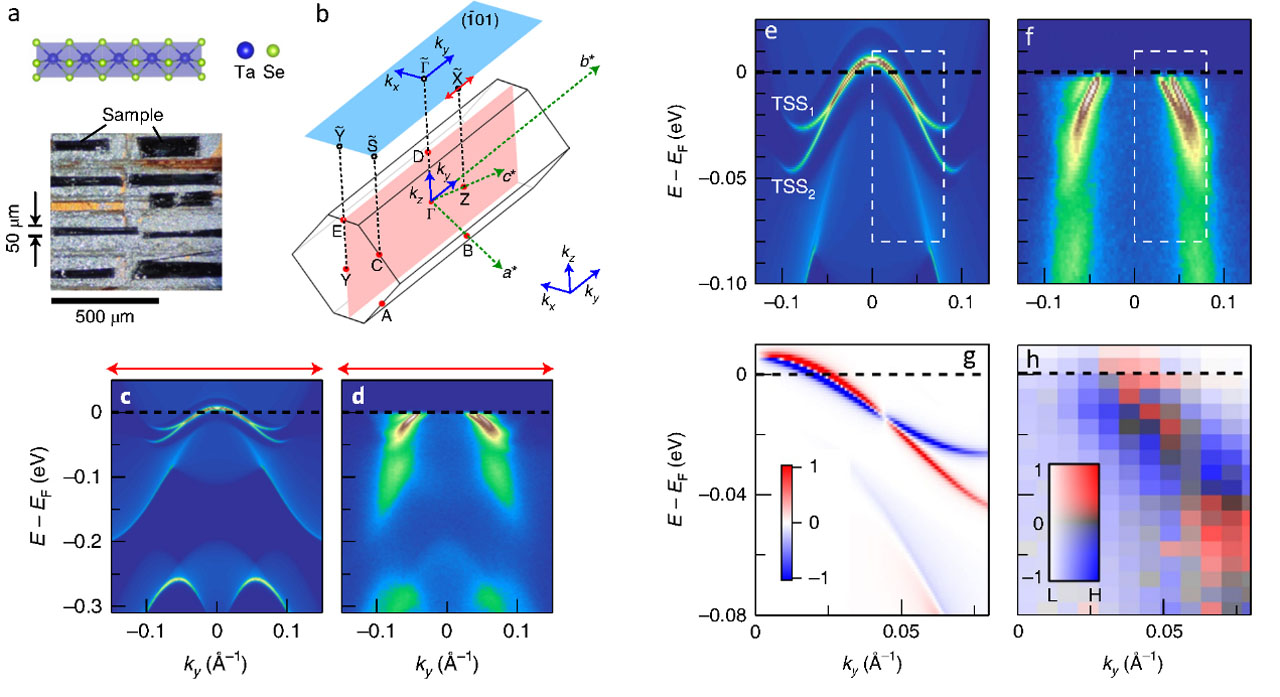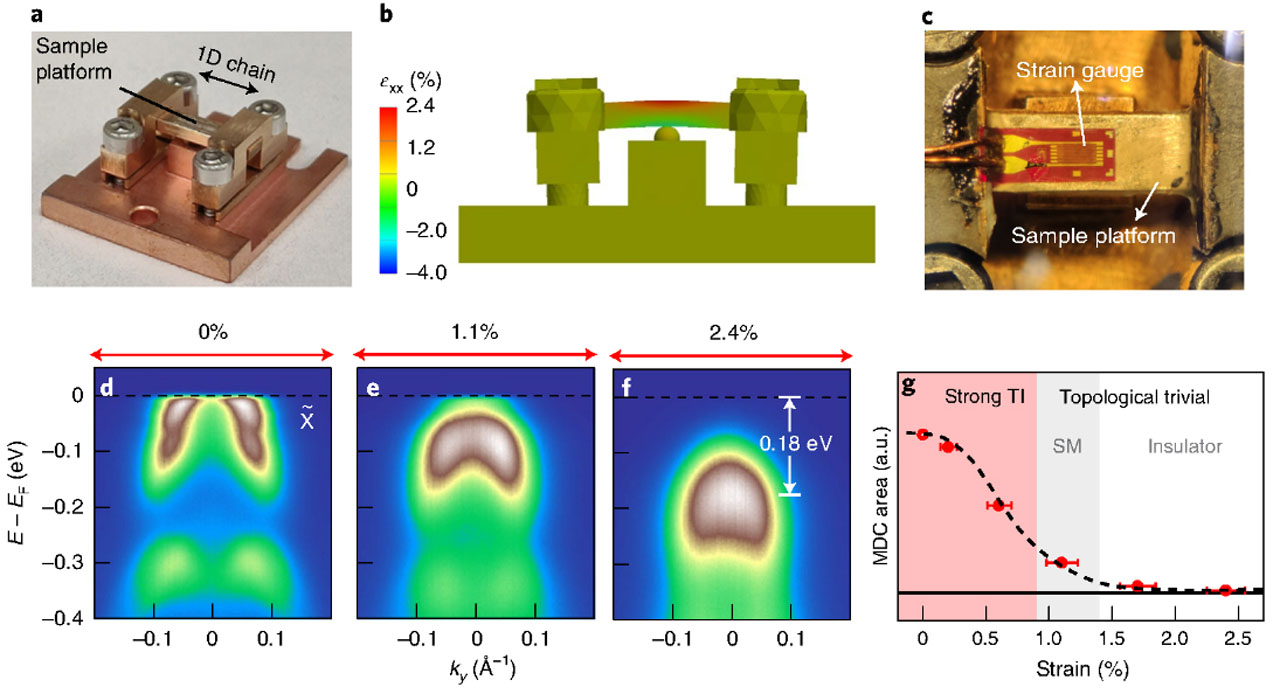Visualization of the strain-induced topological phase transition in a quasi-one-dimensional superconductor TaSe3
Kondo Group
The control of the phase transition from topological to normal insulators can allow for an on/off switching of the spin current. Topological phase transitions realized by elemental substitution [1] require the preparation of materials with various compositions and are thus far from a feasible device application, which demands a reversible operation.
In this study, we use angle-resolved photoemission spectroscopy (ARPES) and spin-resolved ARPES (SARPES) to visualize the strain-driven band-structure evolution of the quasi-one-dimension (quasi-1D) superconductor TaSe3. Our results demonstrate that it undergoes reversible strain-induced topological phase transitions from a strong topological insulator phase with spin-polarized, quasi-one-dimensional topological surface states to topologically trivial semimetal and band insulating phases. The quasi-one-dimensional superconductor TaSe3 provides a suitable platform for engineering the topological spintronics with the functionality to on/off switch a spin current that is robust against impurity scattering.
In the transition-metal trichalcogenides MX3 (M = Nb, Ta; X = S, Se), physical properties vary and electronic orders evolve differently in accordance with the distinctive stacking sequences of the 1D chain variants [2]. Among them, TaSe3 is especially appealing in that superconductivity emerges at low temperatures (~2 K) [3], in contrast with the other members, which typically undergo charge density wave transitions [2]. More intriguingly, recent ab initio calculations predict that semimetallic TaSe3 belongs to a three-dimensional (3D) strong TI phase [4]. Therefore, it has been further suggested as a candidate for a topological superconductor with the topological surface states (TSSs) formed near EF. Thanks to the van der Waals stacking of 1D chains [2] and the electronic proximity to other topological phases [4], TaSe3 potentially brings an attractive functionality of controlling topological properties by fine-tuning of a single physical parameter, i.e., the lattice variation via strain.
In Fig. 1 [5], we demonstrate the first unambiguous confirmation of the strong TI phase in TaSe3. Figures 1c,d shows the calculated and correspondingly experimental band dispersions around the Brillouin zone edge, where the TSSs are expected (the sharp features in Figs. 1c,d). To elucidate more details, we magnify the dispersions in Figs. 1e,f, where one can see clearly two branches of TSSs. Utilizing ultra-high resolution SARPES, we map the spin-resolved states in Fig. 1h within the energy-momentum window specified by the dashed box in Fig. 1f. Correspondingly, the calculations are also shown in Fig. 1g. One can see that our results nicely reproduce the theoretical predictions of spin-polarized states with a spin-degenerated node point.

We have designed a device to apply strain to the quasi-1D crystals, based on a bending mechanism, as shown in Fig. 2a [5]. After tightening four screws, one can apply uniaxial tensile strain to the crystals mounted on the platform. This can be seen in Fig. 2b representing with color scale the distribution of longitudinal strain produced by the finite-element analysis. We also used commercial strain gauges to measure the strain values and confirmed a good agreement of those with the simulations [5]. Figures 2d-f show the band dispersions around the zone edge obtained under different strains tuned in-situ, revealing two-step phase transitions. At zero strain (Fig. 2d), one can see sharp and high-intense TSSs that are consistent with those shown in Figs. 1d,f. With increasing strain up to around 1%, the TSSs vanished (Fig. 2e) as a result of the topological phase transition, i.e., the band inversion is lifted and the bulk gap collapsed, turning the bulk state to the trivial semimetallic phase. As the strain reached 2.4%, the band gap was reopened (Fig. 2f), and a metal-insulator transition occurred. These phase variations are reflected on the ARPES intensity at EF , which is plotted in Fig. 2g as a function of strain values controlled in-situ. Comparing with our calculations, we conclude that we have realized two-step phase transitions, from a strong topological insulator phase, across a topologically trivial semimetallic phase, to a normal band insulator phase.
In summary, we have demonstrated that TaSe3 hosts a strong TI phase in its ground state. By means of in-situ strain engineering of the band structure, we have observed two-step phase transitions in TaSe3, including a topological phase transition from a strong TI phase to a trivial semimetal phase, and a subsequent metal-insulator transition. We note that TaSe3 provides an excellent functionality of easily controlling the band topology by mechanical strain. Such a strain method is much simpler, reversible, and thus promising than element substitution method for future application utilizing topological phase transition. Furthermore, our results give prediction that the Majorana fermions emerge in the TaSe3 superconductor and they are controllable by the strain method, so encouraging follow-up research toward the future realization of the quantum computation.
References
- [1] S.-Y. Xu et al., Science 332, 560 (2011).
- [2] P. Monceau, Adv. Phys. 61, 325 (2012).
- [3] T. Sambongi et al., J. Phys. Soc. Jpn. 42, 1421 (1977)
- [4] S. Nie et al., Phys. Rev. B 98, 125143 (2018).
- [5] C. Lin et al., Nat. Mater. 20, 1093 (2021).

